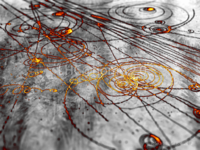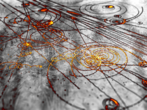Test4Theory
Cs Portal > List of citizen science projects > Test4Theory - (2013/09/24)
IDENTIFICATION
- Beta start date : N/A
- End date : Still open.
- Natural sciences > Particle Physics (physics)
- Others in the same subject areas: Air Quality with Biomarkers, Andromeda Project, Bat detective, Budburst... further results
- Others projects about physics: Einstein@home, Planet Hunters
⇳ Description The LHC@home 2.0 project Test4Theory allows users to participate in running simulations of high-energy particle physics using their home computers. ➠ Purpose The results are submitted to a database which is used as a common resource by both experimental and theoretical scientists working on the Large Hadron Collider at CERN.
Hopefully, these explanations can help give an idea of why the computing resources made available by volunteers in this way can be crucial for improving our understanding of what is really happening inside the beam pipe of the Large Hadron Collider. ? Research question
TEAM
CERN, Geneva, Switzerland
Project team page http://lhcathome.web.cern.ch/test4theory/meet-team Leader: Peter Skands Institution: Partner institutions: Contact: Daniel Lombraña González
USER TASKS
CONTRIBUTION TYPE:
PARTICIPATION TYPOLOGY:
GAMING GENRE NONE
GAMING ELEMENTS: Score boards
◉ Tasks description In order to run the collision simulations you will need to install two key applications in your computer:
- VirtualBox
- BOINC client
Finally, you will have to attach your computer to the project ⤯ Interaction with objects The only interactions are installing software and attaching the computer to the project. ▣ Interface
- Data type to manipulate:
- interface enjoyment: rather not cool/attractive
- Interface usability: somewhat difficult to use
GUIDANCE
- Tutorial: Somewhat
- Peer to peer guidance: Somewhat
- Training sequence: x
- Individual performance: ✓
- Collective performance: ✓
- Research progress: Somewhat
❂ Feedback and guidance description
COMMUNITY
- Communication: forum
- Social Network: N/A
- Member profiles:: minimal
- Member profile elements:
- Main news site:
- Frequency of project news updates: weekly
- Type of events: Hack Days
- Frequency of events :
⏣ Community description
- Community size (volounteers based)
- Role:
- Interaction form:
- Has official community manager(s): yes
- Has team work N/A
- Other:
- Community led additions:
Other information
PROJECT
Url:http://lhcathome.web.cern.ch/test4theory
Start date: 2010/11/24
End date: Still open
Infrastructure: BOINC
TEAM
Official team page:http://lhcathome.web.cern.ch/test4theory/meet-team
Leader: Peter Skands
Main location: CERN, Geneva, Switzerland
PROJECT DEFINITION
Subject
Natural sciences > Particle Physics (physics)
Description
The LHC@home 2.0 project Test4Theory allows users to participate in running simulations of high-energy particle physics using their home computers.
Purpose.
The results are submitted to a database which is used as a common resource by both experimental and theoretical scientists working on the Large Hadron Collider at CERN. Hopefully, these explanations can help give an idea of why the computing resources made available by volunteers in this way can be crucial for improving our understanding of what is really happening inside the beam pipe of the Large Hadron Collider.
.
ABOUT PARTICIPANT TASKS
Tasks description.
In order to run the collision simulations you will need to install two key applications in your computer:
- VirtualBox
- BOINC client
Interaction with system objects.
The only interactions are installing software and attaching the computer to the project.
| Grey typology | Participation typology | Contribution type: | ||||||||||||||||||||||||||||
|---|---|---|---|---|---|---|---|---|---|---|---|---|---|---|---|---|---|---|---|---|---|---|---|---|---|---|---|---|---|---|
|
|
|
||||||||||||||||||||||||||||
| Gaming | ||||||||||||||||||||||||||||||
| Genre: | Gaming elements: score boards | |||||||||||||||||||||||||||||
| Interface | ||||||||||||||||||||||||||||||
| Data type to manipulate: | interface enjoyment: rather not cool/attractive Interface usability: somewhat difficult to use |
Member profiles::minimal Member profile elements: |
||||||||||||||||||||||||||||
ABOUT GUIDANCE AND FEEDBACK
| Guidance | Feedback on | ||||||||||||
|---|---|---|---|---|---|---|---|---|---|---|---|---|---|
|
|
.
COMMUNITY
| Tools | News & Events |
|---|---|
|
Communication: forum |
Main news site: |
| Community description | |
|
Community size (volounteers based): |
|
Other information about community:
Community led additions:
OTHER PROJECT INFORMATION
particlesCol 1.png Yes [[has completion level::Low]
http://lhcathome.web.cern.ch/test4theory/meet-team Daniel Lombraña González CERN, Geneva, Switzerland
Yes
Particle Physics
Natural sciences
physics
The results are submitted to a database which is used as a common resource by both experimental and theoretical scientists working on the Large Hadron Collider at CERN.
Hopefully, these explanations can help give an idea of why the computing resources made available by volunteers in this way can be crucial for improving our understanding of what is really happening inside the beam pipe of the Large Hadron Collider.
World-wide Test4Theory In order to run the collision simulations you will need to install two key applications in your computer:
- VirtualBox
- BOINC client
Finally, you will have to attach your computer to the project
Retributions are given through the BOINC interface, i.e. individual or group performance (??)
, other: Thinking: no Computing: yes Sensing: no Gaming: no score boards
The only interactions are installing software and attaching the computer to the project. rather not cool/attractive somewhat difficult to use somewhat somewhat no yes yes somewhat
minimal
weekly
N/A
Low
Bibliography
| BIBLIOGRAPHY |
Crowd-sourced computing platform reaches one trillion events. Cian O'Luanaigh
- ➥ http://home.web.cern.ch/about/updates/2013/09/crowd-sourced-computing-platform-reaches-one-trillion-events
- ✄ Cian O'Luanaigh, Crowd-sourced computing platform reaches one trillion events, CERN, Web page, 20 Sep 2013, retrieved Sept 24 2013
Crowd-sourced computing platform reaches one trillion events. Cian O'Luanaigh
- http://home.web.cern.ch/about/updates/2013/09/crowd-sourced-computing-platform-reaches-one-trillion-events
- Cian O'Luanaigh, Crowd-sourced computing platform reaches one trillion events, CERN, Web page, 20 Sep 2013, retrieved Sept 24 2013



